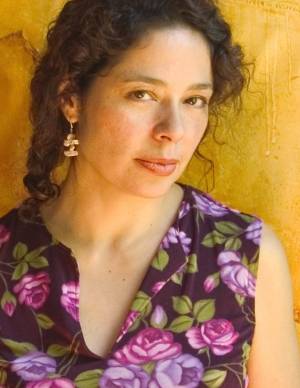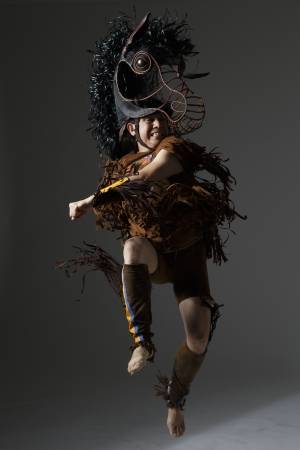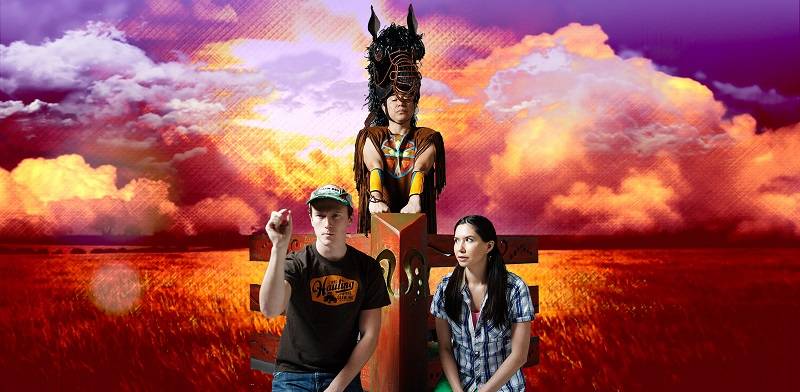A fence is a funny thing, idiomatically. If you’re “on the fence”, you haven’t made up your mind, maybe because you’re looking at the “greener grass on the other side” (but at least the devil you know is on this one). If you’re “mending fences”, you’re trying to give restitution to someone you’ve wronged, but Robert Frost argues in “Mending Wall” that perhaps the adage “good fences make good neighbors” is not always true. How is it that drawing a boundary draws you closer to someone; why is that wisdom? Krannert Center is bringing an interdisciplinary performance to town that takes on the concept of many hyperbolic fences by featuring a physical one.
The fence in Red Sky Performance‘ Mistatim sections off a small corner of the stage with two pivoting segments. In the videos and images I’ve seen, this fence is relatively unassuming, could be dismissed as just set dressing. What’s unique about it is that it is the dividing line between the ranch that Calvin’s family owns and the reservation where Speck lives. It changes configuration and position throughout the course of the show: it suggests boundaries, it becomes a temporary dressage obstacle, it’s necessary for stage illusions, it is seen from all sides and angles. The one thing it doesn’t really seem to do is obstruct: what kid ever let a fence keep them out of anything?
And that seems to be the point: most of the fence-folk sayings revolve around livestock – which are famously not very intelligent – hence the need for fences. In this play, Mistatim is also the name of a horse which needs to be broken. Calvin’s trying to do it to impress his father, Speck has the training and the inherent gifts to do it. As the children become friends with each other and the horse, they find themselves learning about each other and questioning the information they’ve learned by rote.
Red Sky Performance is a company from Canada which features contemporary Indigenous performance with dance, theatre, music, and media. A wholly original production encompassing all these elements, Mistatim was conceived by artistic director Sandra Laronde, written by Erin Shields, directed by Andrea Donaldson, and choreographed by Laronde and Carlos Rivera, the latter originating the title role. Rivera will also be performing as Mistatim during the shows at Krannert, along with Samantha Brown as Speck and Dustin Luck as Calvin.
 When I approached Red Sky for an interview, Ms. Laronde made herself available to us. It was she who took the idea of a horse whisperer leading “through firm gentleness, deep knowledge and compassion” and asked playwright Shields to script the work, and asked Andrea Donaldson to direct. Together, the team and Red Sky Performance were able to create a show that not only was nominated for a Dora Mavor Moore award in 2016, but also fit Red Sky’s vision of “exceptional programming informed by Indigenous cultures and worldviews”. Originally from the Teme-Augama-Anishinaabe (People of the Deep Water), this mission has been an important goal in all of Ms. Laronde’s artistic endeavors, including while she was at the Banff Centre for Arts and Creativity, as well as currently as a Curator for the Toronto Symphony Orchestra. It was my pleasure to speak with such a focused and influential woman.
When I approached Red Sky for an interview, Ms. Laronde made herself available to us. It was she who took the idea of a horse whisperer leading “through firm gentleness, deep knowledge and compassion” and asked playwright Shields to script the work, and asked Andrea Donaldson to direct. Together, the team and Red Sky Performance were able to create a show that not only was nominated for a Dora Mavor Moore award in 2016, but also fit Red Sky’s vision of “exceptional programming informed by Indigenous cultures and worldviews”. Originally from the Teme-Augama-Anishinaabe (People of the Deep Water), this mission has been an important goal in all of Ms. Laronde’s artistic endeavors, including while she was at the Banff Centre for Arts and Creativity, as well as currently as a Curator for the Toronto Symphony Orchestra. It was my pleasure to speak with such a focused and influential woman.
SP: Red Sky has an impressive mission, to “create a leading international company that shapes contemporary world Indigenous performance, and to make a significant contribution to the artistic vibrancy of Canada and the world.” Other than your broad pursuit, what’s your favorite part about being involved with Red Sky?
Laronde: My favourite part about being involved with Red Sky is that the vision is deep and wide, sustaining, and brings together many peoples through original productions. As the Artistic Director of Red Sky Performance, I am deeply invested in creating a new lens; a new lens for people to see with fresh eyes and to see nature as sentient, intact and alive.
Through the work at Red Sky, we also get to see the world such as far flung places like Mongolia, China, Australia, and Iceland to name a few. We also get to perform in multiple states in the USA, and it is a pleasure to be here in Illinois.
SP: What was the inspration behind MIstatim?
Laronde: What I conceived is not just the empathy and compassion [you] mentioned, it was also more practical; it is a story about the taming of a wild horse and the different methods in which different cultures do so. It is about having a wild horse turn their worlds upside down so that they have to learn something quite different about each other. It is also idea of a horse whisperer leading “through firm gentleness, deep knowledge and compassion”.
SP: One of the most amazing things, to me, about art is its fluidity in context. Although Mistatim must have been written at least three years ago, the theme of trust and the symbol of the fence both strike me as especially significant during this moment in North American history. Have you seen any differences in audience reactions to your recent performances?
Laronde: The fence is a symbol of the cultural divide between First Peoples and White people, and it also separates land between reservation and ranch. It is similar to a wall, and yes, people do see the significance as they respond to the fence. The fence is about keeping things out, and keeping things in. What we want to convey through the telling of Mistatim is that children are much more ready to climb over fences. They ask all kinds of good questions without making anyone into the “other”. Mistatim has many ‘fences” such as boy/girl, adult/child, human/animal, and human/land. The Indigenous mindset is not that it is man versus nature at all, but rather more like man and nature and even better man with nature. Mistatim shows young people that they have the potential to re-map and re-think the way that they understand their world.
SP: Were there any particular pre-conceptions (in either direction) that you were expressly hoping to address through the formation of the core friendships between both children and the horse in Mistatim?
Laronde: Yes, that children form preconceptions of one another early on and it is often based on their parents and grown-ups, and media. It takes getting to know someone on a personal level to truly understand them, and to break down that barrier or that fence that was built in their mind. A fence or a wall goes up often based on fear and the desire to control and limit. We need a new 21st century framework for education on First Peoples, and one that takes it out of the negative or “deficit paradigm”. This story does that through multiple layers.
 SP: While dance is a very powerful and evocative medium, sometimes it can be hard to feel like one is interpreting it “correctly”. Is there anything you would explain more fully to an audience member who might be concerned about following along?
SP: While dance is a very powerful and evocative medium, sometimes it can be hard to feel like one is interpreting it “correctly”. Is there anything you would explain more fully to an audience member who might be concerned about following along?
Laronde: Mistatim [the play] is multidisciplinary in nature, and therefore combines dance, mask work, theatre, and storytelling, and it is not difficult to follow along. You are right in that dance is very powerful medium and it often reveals a vitality that text cannot do on stage. Mistatim [the horse] is the embodiment of all that is Indigenous, and he is deeply connected to land and space. Everything is told through his body and through movement; it is his world.
SP: Although this work is being presented as part of our Youth Series, there is an evening performance for all audiences. What do you feel this production has to offer an adult viewer?
Laronde: At Red Sky, we love creating moments and scenarios where children, parents and families alike laugh together in the same place, but often for different reasons. We love creating this multi-layered approach to story. This production offers the adult viewer something that is rare, and that you cannot see on television or in the movies. I have also witnessed many adults cry or be quite moved because they get the story on another level entirely. It is wonderfully visual, intelligent, fun, and moving all at once. Adults do learn along with the children about Indigenous cultures through this production. It is also a story about leadership without ever saying the word in the entire piece. So, if there are any adults that are life learners, curious, and want something new to see/learn, please come on down to see Mistatim.
Mistatim will be performed for the general public on one night only: Friday, February 10th at 7 p.m. It is recommended for ages 8 and up, and we mean “and up” because regardless of age, anyone can receive more wisdom. Tickets start at $24, but all the usual Krannert discounts apply, please see the event website for exact details and to purchase your ticket. Of course, tickets can always be obtained at the ticket office or by calling 1-800-KCPA-TIX during office hours.
[Editor’s note: an earlier publication of this article incorrectly referred to the company as “Red Sky Productions” instead of “Red Sky Performance”. We apologize for this error and it has been corrected.]








